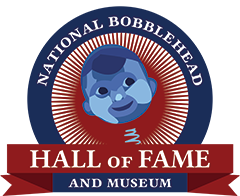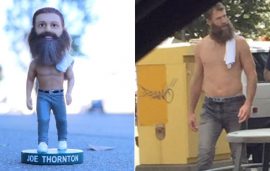From The Wall Street Journal –
Last month, Jason Ray drove to Chicago from his home near Minneapolis and bought five cheap tickets to a Chicago Bulls basketball game.
Mr. Ray, 26 years old, didn’t care about the game the Bulls were playing against the Milwaukee Bucks. He just wanted bobblehead dolls of Bulls forward Elton Brand. The Bulls were giving away the 7.5-inch statuettes with jiggling, oversized heads to the first 5,000 fans attending the game.
In the sports-giveaway business, bobblehead dolls are becoming the Beanie Babies of the new millennium. Also known as “bobbing heads” or “nodders,” bobbleheads were stadium staples in the 1960s and early ’70s, when they sold at souvenir stands for a couple of bucks. Now they’re drawing a rabid new cult.
Two summers ago the San Francisco Giants, as part of a series of turn-back-the-clock promotions marking their last season at Candlestick Park, (renamed 3Com Park) handed out a Willie Mays bobblehead. Twice the usual number of fans turned out.
This year more than 20 teams in Major League Baseball have scheduled bobblehead giveaways, and have sold thousands of advance tickets for those games. A dozen National Basketball Association clubs have gotten into the act. Alexander Global Promotions Inc. of Bellevue, Wash., makes most of the dolls — 280,000 a month, in China. The company is developing prototypes for the Women’s National Basketball Association and the PGA golf tour, and PepsiCo has contracted it to make dolls of about 40 college mascots, including Stanford University’s tree.
With their giant, springy heads, the kitschy bobbleheads may be cute. But the main reason for the fanaticism is a booming secondary market. Bobbleheads are fresh meat for collectors and dealers. Limited runs — teams generally don’t give away more than 10,000 dolls based on the likenesses of the most popular players — create the instant scarcity that collectors covet. Some new dolls have sold for hundreds of dollars in Internet auctions.
At a game in Minneapolis last summer, fans camped out overnight and then pushed, shoved, bribed and argued in line for a giveaway of 10,000 bobbleheaded Kirby Pucketts. With dolls of the retired Minnesota Twins outfielder in hand, some ticket holders didn’t bother to stay for the game. “People in Minnesota don’t riot,” says Twins business executive Dave St. Peter. “But it was probably as close as we get.”
Last month in Philadelphia, where people do riot, some fans enlisted children to obtain dolls of 76ers guard Allen Iverson offered to 5,000 ticket holders 14 and under. Sixers senior vice president Dave Coskey says a pregnant woman asked for a doll for her unborn child. A fan said he wanted one for his critically ill daughter. Mr. Coskey told him he should be at the hospital, not at a basketball game. One patron was ejected for threatening a 76ers employee. “People were abusive,” Mr. Coskey says.
The most elaborate scam took place in December, when the NBA’s Minnesota Timberwolves gave away a doll of forward Wally Szczerbiak. Everyone in attendance got a coupon numbered 1, 2, 3 or 4, and a lottery drawing was held at halftime. Crunch, the team mascot, selected the winner, No. 3.
As fans picked up their dolls, Timberwolves officials realized that the color was slightly off on some of the coupons. They surmised that somebody had taken coupons to a copy center, and then either amassed dolls with the fakes or sold winning numbers for $5 or $10 apiece. Police were called, but there were no arrests, says Timberwolves marketing director Chris Wright.
Dealers post dolls for auction on eBay a few days before a giveaway to establish a price. Earlier this month, a seller listed a doll of Orlando Magic forward Grant Hill three days early; the doll fetched $55.25. Others go from arena to arena collecting freebies for resale. “I’ve gotten at least 100 in the last year,” says Mr. Ray, who manages a newspaper-distribution depot. He picked up five Elton Brand dolls with the tickets he bought in Chicago. He bought 10 more from fans outside the United Center. He says he has sold some on his bobblehead Web site for more than $30 each.
A buyer on eBay paid $315 for an Iverson doll this month. A set of four Twins dolls (Mr. Puckett, Kent Hrbek, Harmon Killebrew and Tony Oliva) recently sold for $375. Five Timberwolves dolls (Mr. Szczerbiak, Kevin Garnett, Chauncey Billups, Terrell Brandon and Sam Mitchell) fetched $305.01. The Twins set, collectors say, sold for about $700 last summer soon after the dolls came out.
Tim Hunter, a bobblehead dealer in Reno, Nev., and author of “Bobbing Head Dolls 1960-2000,” a price guide, predicts the new dolls won’t sustain the prices amateurs are paying for them. Of the Iverson doll, he says: “In two years it’ll be going for $20.”
Crude bobbleheads of policemen, clowns and baseball players were made in the early 1900s. But the ’60s were the real heyday, with the spring-attached, boyish heads atop the uniforms of most pro sports teams, as well as dolls of pop icons including the Beatles, Fidel Castro and Colonel Sanders. Some had magnets, so they could be attached to dashboards. The sports dolls weren’t big sellers.
Vintage nodders are categorized by facial style (“moon face,” “boy face,” “realistic face”) and other physical characteristics (“toes up,” “ear pads”). Mr. Hunter says the most valuable bobblehead ever was a black Houston Colt .45s baseball player with a realistic face (of nobody in particular) circa 1962, which sold two years ago for $8,400.
Unlike the new poly-resin and ceramic dolls, most of the older bobbleheads were made of papier-mache, which collectors say allowed for finer painting detail. Serious collectors can even identify some of the Japanese-made dolls by their artists. Mr. Hunter particularly admires one artist for the “magnificent shading” on the cheeks of white-faced Milwaukee Braves dolls from the early ’60s. “They’re really miniature works of art,” Mr. Hunter says.
The modern nodders have their own distinction: verisimilitude. The Iverson doll, for instance, displays the tattoos on his arms and neck, his cornrow hair, chin stubble and diamond earrings. Lara White, the 76ers’ marketing vice president, boasts that it’s the most lifelike in the NBA.
Players are finicky about how they are presented. Mr. Garnett of the Timberwolves complained that on the doll his biceps and triceps weren’t “cut,” or well-defined. Stephon Marbury of the New Jersey Nets insisted on earrings. Another NBA player told the doll’s manufacturer: “My butt’s too big.”
When Dave Winfield learned that the Twins wanted to make bobbleheads of him and Mr. Puckett to honor their induction into the Baseball Hall of Fame, he had one stipulation, a Twins executive says: The doll of the 6-foot-6 Mr. Winfield had to be an inch taller than that of his pudgy, 5-foot-8 former teammate. Mr. Winfield won’t admit to requesting that, but he likes the way it turned out. “It’s more realistic,” he says. “I was a tall guy.”
Dow Jones & Company

